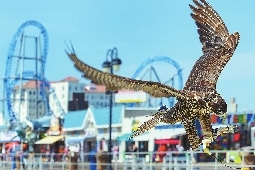
FOR years, tourists enjoying the picturesque boardwalk in Ocean City, New Jersey, the U.S., have had to deal with some unwelcome visitors: marauding seagulls intent on stealing their lunch. Ocean City, about 200 kilometers south of New York, welcomes 150,000 holidaymakers every summer. They come for the beaches, Atlantic Ocean views, and countless snack bars and ice cream stands. Thousands upon thousands of seagulls follow them, though, regularly swooping down to pluck French fries or funnel cake from the hands of unsuspecting tourists, sometimes leaving children in tears. “It’s not that pleasurable to have to guard your food,” said Hilary Larkin, who has been holidaying at the seaside resort for 36 years. The city’s government decided enough was enough and tasked East Coast Falcons – a group of falconers more used to protecting airports, farmland and landfill sites against invading birds – to do something about them. Although the raptors could easily kill the seagulls, they have been trained not to. Blackberry, a 3-year-old peregrine falcon does the morning shift, performing a wide sweep of the skies before returning to falconer PJ Simonis’s hand. The Harris’s hawks, native to the desert, work the afternoon when temperatures are high. Ozzy, the Eurasian eagle-owl, is from the Arctic and does not like heat so he spends most of the day being cooled by air conditioning before undertaking a few laps after dark before the falconers head home at 11 p.m. In just three short weeks, most seagulls have got the message, heading back out to their natural habitat to scavenge for clams, crabs and mussels. Mayor Jay Gillian said in a post on his website this month that the scheme, which costs US$2,100 a day, appeared to be working and could be renewed next summer. The raptors have also become a tourist attraction in their own right. “Just about everybody has had positive things to say,” said Simonis. “People have had tears in their eyes, so happy that they could eat on the beach and boardwalk again without being attacked by seagulls.” (SD-Agencies) | 
